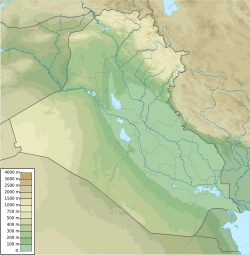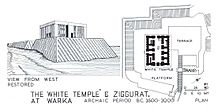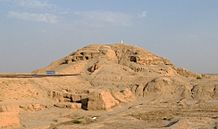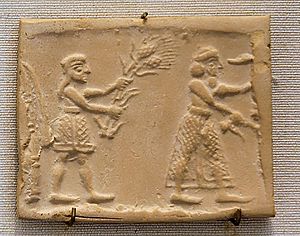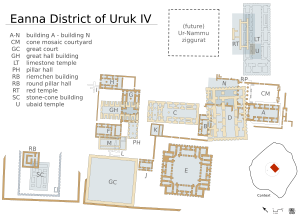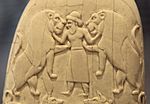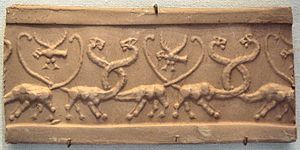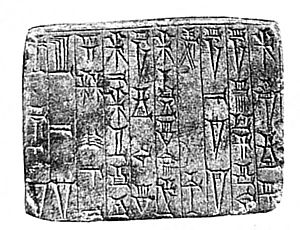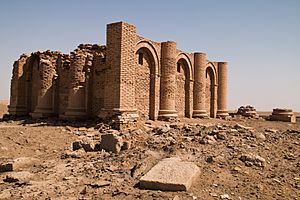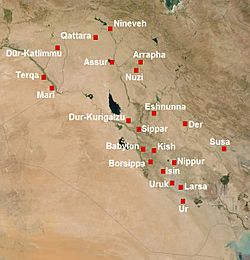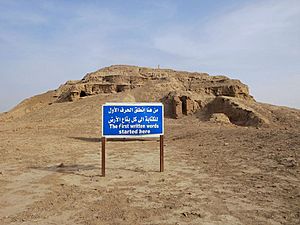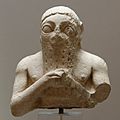Uruk facts for kids
| Location | Al-Warka, Muthanna Governorate, Iraq |
|---|---|
| Region | Mesopotamia |
| Coordinates | 31°19′27″N 45°38′14″E / 31.32417°N 45.63722°E |
| Type | Settlement |
| Area | 6 km2 (2.3 sq mi) |
| History | |
| Founded | c. 5000 BC |
| Abandoned | c. 700 AD |
| Periods | Uruk period to Early Middle Ages |
| Site notes | |
| Excavation dates | 1850, 1854, 1902, 1912–1913, 1928–1939, 1953–1978, 2001–2002, 2016–present |
| Archaeologists | William Loftus, Walter Andrae, Julius Jordan, Heinrich Lenzen, Margarete van Ess |
| UNESCO World Heritage Site | |
| Official name | Uruk Archaeological City |
| Part of | Ahwar of Southern Iraq |
| Criteria | Mixed: (iii)(v)(ix)(x) |
| Inscription | 2016 (40th Session) |
| Area | 541 ha (2.09 sq mi) |
| Buffer zone | 292 ha (1.13 sq mi) |
Uruk, also known as Warka, was a very old city in the Near East. It was located on a dried-up channel of the Euphrates River in what is now Iraq. The city was about 93 kilometers (58 miles) northwest of ancient Ur. It was also about 108 kilometers (67 miles) southeast of Nippur.
Uruk is famous for the Uruk period, a time when cities first started to grow. It played a big part in the early growth of cities in Sumer around 3500 BC. By 3100 BC, Uruk might have had 40,000 people living there. Another 80,000 to 90,000 people lived in the areas nearby. This made it the largest city in the world at that time.
King Gilgamesh, a famous hero, ruled Uruk in the 27th century BC. The city became less important around 2000 BC. This happened during fights between Babylonia and Elam. But people continued to live there during the Achaemenid Empire (550–330 BC), Seleucid Empire (312–63 BC), and Parthian (227 BC to AD 224) periods. Uruk was finally left empty around 700 AD.
William Kennett Loftus visited Uruk in 1849. He recognized it as "Erech," a city mentioned in the Bible. He led the first excavations there from 1850 to 1854.
Contents
Understanding the Name of Uruk
Uruk's name was written in several ways using cuneiform script. In the Sumerian language, it was unugki. In the Akkadian language, it was Uruk.
The modern country of Iraq is often thought to get its name from Uruk. However, it probably came from the Middle Persian word Erāq. This word then came from the Aramaic language ’yrg. But this Aramaic word might still be linked to the Uruk region of southern Mesopotamia.
Why Uruk Was Important
In old stories and books, Uruk was known as the main city of Gilgamesh. He was the hero of the famous Epic of Gilgamesh. Experts also believe Uruk is the biblical city of Erech. This city is mentioned in the Book of Genesis as the second city founded by Nimrod.
The Uruk Period: A Time of Growth
Uruk was one of the very first cities ever built. It was also the main reason for the growth of cities and governments during the Uruk period (4000–3200 BC). This time, also called the 'Uruk expansion', lasted 800 years. During this period, small farming villages changed into large city centers. Other settlements existed, but Uruk was much bigger and more complex.
The culture of the Uruk period spread through Sumerian traders and settlers. This influenced all the people living nearby. They slowly developed their own similar economies and cultures. In the end, Uruk could not keep control over distant settlements like Tell Brak by force.
How Geography Helped Uruk Grow
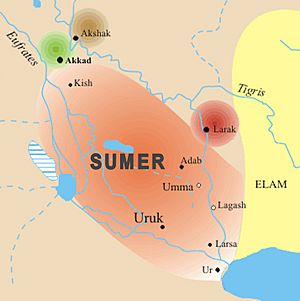
Uruk's amazing growth was due to its location. The city was in southern Mesopotamia, a very old place where civilization began. It was right on the Euphrates River. People learned to grow grains from the Zagros Mountains foothills. They also used advanced irrigation to water their crops. This helped the area grow many different kinds of food. Growing grains and being near rivers helped Uruk become the largest Sumerian settlement. It grew easily in both population and size.
Uruk had a lot of extra food and many people. This helped things like trade, specialized jobs, and the development of writing. Writing might have started in Uruk around 3300 BC. Digs have found many pottery pieces and the oldest known writing tablets. These show how these things developed. Digging at Uruk is hard because old buildings were often used to build new ones. This mixes up the layers from different time periods. The top layer likely came from the Jemdet Nasr period (3100–2900 BC). It was built on older structures from the Ubaid period.
Uruk's Long History
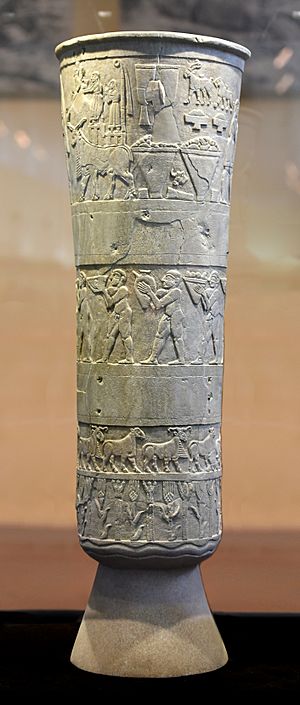
According to the Sumerian King List, King Enmerkar founded Uruk. The epic Enmerkar and the Lord of Aratta says that Enmerkar built the House of Heaven for the goddess Inanna. This temple was in the Eanna District of Uruk. In the Epic of Gilgamesh, Gilgamesh is said to have built the city wall around Uruk. He was also the city's king.
Uruk grew in several stages, from the Early Uruk period (4000–3500 BC) to the Late Uruk period (3500–3100 BC). The city formed when two smaller Ubaid settlements joined together. Their main temple areas became the Eanna District and the Anu District. These were dedicated to Inanna and Anu. The Anu District was first called 'Kullaba' before it joined the Eanna District. Kullaba was one of the oldest and most important cities in Sumer.
The Eanna District had many buildings with workshops. It was also surrounded by a wall. The Anu District was built on a high terrace with a temple at the top. The Eanna District was clearly dedicated to Inanna throughout Uruk's history. The rest of the city had typical houses with courtyards. These houses were grouped by the jobs of the people living there. Uruk had a very good system of canals. It was like "Venice in the desert." These canals flowed through the city, connecting it to trade on the old Euphrates River. They also connected it to the farms around the city.
The original city of Uruk was southwest of the old Euphrates River, which is now dry. Today, the site of Warka is northeast of the modern Euphrates River. The river changed course at some point in history. This, along with salt buildup from irrigation, might have caused Uruk to decline.
Layers of Uruk's Past
Archaeologists have found many cities of Uruk built on top of each other. Each layer represents a different time period:
- Uruk XVIII Eridu period (around 5000 BC): Uruk was founded.
- Uruk XVIII–XVI Late Ubaid period (4800–4200 BC)
- Uruk XVI–X Early Uruk period (4000–3800 BC)
- Uruk IX–VI Middle Uruk period (3800–3400 BC)
- Uruk V–IV Late Uruk period (3400–3100 BC): The first huge temples of the Eanna District were built.
- Uruk III Jemdet Nasr period (3100–2900 BC): The 9 km city wall was built.
- Uruk II
- Uruk I
The Anu District: A Sky God's Home
The Anu district had one huge terrace, the Anu Ziggurat. This was a temple dedicated to Anu, the Sumerian sky god. Around the Uruk III period, the massive White Temple was built on top of the ziggurat. A structure from the Uruk VI period, called the Stone Temple, was found under the ziggurat's northwest edge.
The Stone Temple was made of limestone and bitumen. It was built on a platform of rammed earth and covered with lime plaster. This platform was built over a special woven reed mat called ĝipar. This mat was used in rituals. The Stone Temple's design showed ideas from the Enuma Elish story. It might have been used for pouring liquids in ceremonies. The temple was later destroyed on purpose. It was covered with layers of clay and stone, then dug up and filled with mortar.
The Anu Ziggurat started as a large mound with a small room (cella) on top around 4000 BC. It was built up over 14 stages. In phase E, around 3200–3000 BC, the White Temple was built. This temple was 21 meters (69 feet) high and covered in gypsum plaster. It reflected sunlight like a mirror and could be seen from far away. The Anu Ziggurat also had a grand limestone staircase. A channel next to the staircase was used to drain water from the ziggurat.
The Eanna District: Where Writing Began
The Eanna district is very important because writing and huge public buildings first appeared here. This happened during Uruk periods VI–IV. These two developments together make Eanna arguably the first real city and civilization in human history. The Eanna IVa period has the earliest examples of writing.
The first building in Eanna, the Stone-Cone Temple (Mosaic Temple), was built in period VI. It was built over an older Ubaid temple. It had a limestone wall with many buttresses. This temple, named for its mosaic of colored stone cones, might have been the earliest place for water worship in Mesopotamia. It was "destroyed by force" in the Uruk IVb period. Its contents were buried in the Riemchen Building.
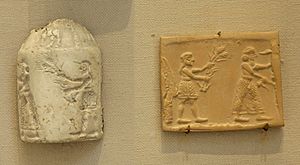
In the next period, Uruk V, the Limestone Temple was built about 100 meters (328 feet) east of the Stone-Cone Temple. It was on a 2-meter (6.6-foot) high rammed-earth platform. This temple also continued the Ubaid culture. However, the Limestone Temple was huge and used stone, which was new for Ubaid architecture. The stone came from a quarry about 60 kilometers (37 miles) east of Uruk. It's not clear if the whole temple or just its foundation was made of limestone. The Limestone Temple was probably the first temple for Inanna, but we can't be sure. Like the Stone-Cone temple, it was also covered in cone mosaics. Both temples were rectangles with their corners pointing to the main directions. They had a central hall with two smaller halls along the long side. They also had buttressed walls. This design became the model for all future Mesopotamian temples.
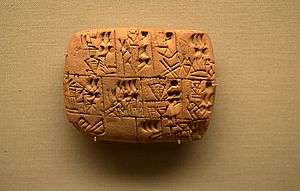
Between these two huge buildings, a group of structures was built during Eanna IVb. These included buildings A–C, E–K, the Riemchen Building, and the Cone-Mosaic Temple. They were built during a time when Uruk was growing fast. The city reached 250 hectares and started long-distance trade. The Riemchen Building was a memorial with a ritual fire. It was kept burning for the Stone-Cone Temple after it was destroyed. The bricks used in this temple were used for all buildings in the Uruk IV period Eanna. The use of colored cones for decoration also became very popular. The Cone-Mosaic Temple was the most impressive building in Eanna at that time. It had three parts: Temple N, the Round Pillar Hall, and the Cone-Mosaic Courtyard. All these buildings were destroyed on purpose. The entire Eanna district was rebuilt in period IVa on an even grander scale.
During Eanna IVa, the Limestone Temple was torn down. The Red Temple was built on its foundations. The leftover materials from the Uruk IVb buildings were used to make a terrace. On this terrace, Buildings C, D, M, the Great Hall, and the Pillar Hall were built. Building E was first thought to be a palace, but it was later found to be a community building. Also in period IV, the Great Court was built. This was a sunken courtyard with two levels of benches covered in cone mosaics. A small aqueduct drained into the Great Courtyard. It might have watered a garden once. The impressive buildings of this period were built when Uruk was at its peak. The city grew to 600 hectares. All the buildings of Eanna IVa were destroyed in Uruk III, but the reasons are not clear.
The architecture of Eanna in period III was very different. The large temples were replaced with baths around the Great Courtyard and the complex Rammed-Earth Building. This period was around 2900 BC, a time of big social changes. Uruk's power was challenged by other city-states. The fortress-like buildings from this time show that there was a lot of trouble. The temple of Inanna continued to be used, but in a new form and with a new name: 'The House of Inanna in Uruk'. We don't know where this building was located.
Uruk in Later Times
Uruk was a busy city in Early Dynastic Sumer. But it was later taken over by the Akkadian Empire and started to decline. Later, during the Neo-Sumerian period, Uruk became important again. It was a major center for business and culture under the rule of Ur. The Eanna District was rebuilt as part of a big building plan. This included a new temple for Inanna. This temple had a ziggurat, the 'House of the Universe'. It was northeast of the old Eanna ruins.

This ziggurat is also called the Ur-Nammu Ziggurat, after its builder Ur-Nammu. After Ur fell around 2000 BC, Uruk declined sharply. It stayed that way until about 850 BC when the Neo-Assyrian Empire took it over. Under the Neo-Assyrians and Neo-Babylonians, Uruk became great again. Around 250 BC, a new temple complex called the 'Head Temple' was added. It was northeast of the old Anu district. This temple was one of the two main centers for Babylonian astronomy. All the temples and canals were rebuilt again under Nabopolassar. During this time, Uruk was divided into five main areas.
Uruk, known as Orcha to the Greeks, continued to do well under the Seleucid Empire. During this time, Uruk was a city of 300 hectares (740 acres) and perhaps 40,000 people. In 200 BC, the 'Great Sanctuary' of Ishtar was added between the Anu and Eanna districts. The ziggurat of the temple of Anu, rebuilt in this period, was the largest ever built in Mesopotamia. When the Seleucids lost Mesopotamia to the Parthians in 141 BC, Uruk was still used. Uruk's decline after the Parthians might have been partly because the Euphrates River changed its path. By 300 AD, Uruk was mostly empty. But a group of Mandaeans settled there. By around 700 AD, it was completely abandoned.
Uruk's Political Role
Uruk played a very important part in the political history of Sumer. From the Early Uruk period, the city was in charge of nearby settlements. Around 3800 BC, there were two main centers: Uruk in the south and Nippur in the north. Both were about 20 hectares (49 acres) in size. They were surrounded by much smaller 10-hectare (25-acre) settlements. Later, in the Late Uruk period, its influence spread over all of Sumer and even to settlements in upper Mesopotamia and Syria.
The famous historian Oppenheim wrote: "In Uruk, in southern Mesopotamia, Sumerian civilization seems to have reached its creative peak. This is pointed out repeatedly in the references to this city in religious and, especially, in literary texts, including those of mythological content; the historical tradition as preserved in the Sumerian king-list confirms it. From Uruk the center of political gravity seems to have moved to Ur."
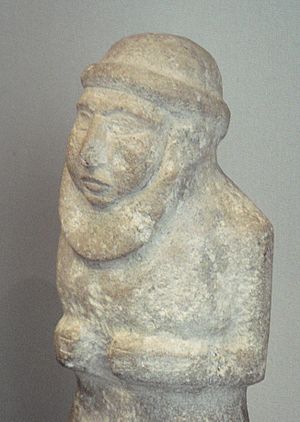
The list of Uruk's rulers includes both mythical and historical figures. Power slowly moved from the temple to the palace. Rulers from the Early Dynastic period controlled Uruk and sometimes all of Sumer. In myths, kingship was given from heaven to Eridu. Then it passed through five cities until a great flood ended the Uruk period. After that, kingship went to Kish at the start of the Early Dynastic period. This was the beginning of the Bronze Age in Sumer.
In the Early Dynastic I period (2900–2800 BC), Uruk was supposedly under Kish's control. This time is sometimes called the Golden Age. During the Early Dynastic II period (2800–2600 BC), Uruk was again the most powerful city in Sumer. This period is the time of the First Dynasty of Uruk, sometimes called the Heroic Age. However, by the Early Dynastic IIIa period (2600–2500 BC), Uruk had lost its power to Ur. This period was the end of the First Dynasty of Uruk. In the Early Dynastic IIIb period (2500–2334 BC), Uruk continued to be ruled by Ur.
Rulers of Uruk Through Time

The lists of rulers come from the Sumerian King List. Its historical accuracy can be debated.
In 2009, two copies of an inscription suggested a 19th-century BC ruler of Uruk named Naram-sin.
Uruk remained a part of Ur, Babylon, and later the Achaemenid, Seleucid, and Parthian Empires. It had short times of independence during the Isin-Larsa period. Kings like Ikūn-pî-Ištar (around 1800 BC) and Sîn-kāšid ruled then. The city was finally destroyed by the Arab invasion of Mesopotamia and abandoned around 700 AD.
Uruk's Amazing Buildings

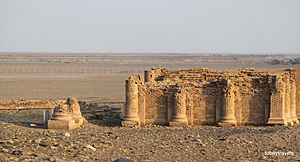
Uruk has some of the first huge buildings in history. They were certainly the largest of their time. Many buildings in the Near East can trace their designs back to these early Uruk structures. The buildings of Uruk are named in two ways: a German name from the first digs, and its English translation. The layers of the site are complex, so some dates are debated. Generally, the buildings follow two main types of Sumerian architecture:
- Tripartite: With three parallel halls.
- T-Shaped: Also with three halls, but the central one extends into two side areas at one end.
The table below summarizes the important buildings in the Eanna and Anu Districts. Temple N, Cone-Mosaic Courtyard, and Round Pillar Hall are often called one structure: the Cone-Mosaic Temple.
| Eanna district: 4000–2000 BC | ||||||
|---|---|---|---|---|---|---|
| Structure name | German name | Period | Typology | Material | Area in m2 | |
| Stone-Cone Temple | Steinstifttempel | Uruk VI | T-shaped | Limestone and bitumen | x | |
| Limestone Temple | Kalksteintempel | Uruk V | T-shaped | Limestone and bitumen | 2373 | |
| Riemchen Building | Riemchengebäude | Uruk IVb | unique | Adobe brick | x | |
| Cone-Mosaic Temple | Stiftmosaikgebäude | Uruk IVb | unique | x | x | |
| Temple A | Gebäude A | Uruk IVb | Tripartite | Adobe brick | 738 | |
| Temple B | Gebäude B | Uruk IVb | Tripartite | Adobe brick | 338 | |
| Temple C | Gebäude C | Uruk IVb | T-shaped | Adobe brick | 1314 | |
| Temple/Palace E | Gebäude E | Uruk IVb | unique | Adobe brick | 2905 | |
| Temple F | Gebäude F | Uruk IVb | T-shaped | Adobe brick | 465 | |
| Temple G | Gebäude G | Uruk IVb | T-shaped | Adobe brick | 734 | |
| Temple H | Gebäude H | Uruk IVb | T-shaped | Adobe brick | 628 | |
| Temple D | Gebäude D | Uruk IVa | T-shaped | Adobe brick | 2596 | |
| Room I | Gebäude I | Uruk V | x | x | x | |
| Temple J | Gebäude J | Uruk IVb | x | Adobe brick | x | |
| Temple K | Gebäude K | Uruk IVb | x | Adobe brick | x | |
| Temple L | Gebäude L | Uruk V | x | x | x | |
| Temple M | Gebäude M | Uruk IVa | x | Adobe brick | x | |
| Temple N | Gebäude N | Uruk IVb | unique | Adobe brick | x | |
| Temple O | Gebäude O | x | x | x | x | |
| Hall Building/Great Hall | Hallenbau | Uruk IVa | unique | Adobe brick | 821 | |
| Pillar Hall | Pfeilerhalle | Uruk IVa | unique | x | 219 | |
| Bath Building | Bäder | Uruk III | unique | x | x | |
| Red Temple | Roter Tempel | Uruk IVa | x | Adobe brick | x | |
| Great Court | Großer Hof | Uruk IVa | unique | Burnt Brick | 2873 | |
| Rammed-Earth Building | Stampflehm | Uruk III | unique | x | x | |
| Round Pillar Hall | Rundpeifeilerhalle | Uruk IVb | unique | Adobe brick | x | |
| Anu district: 4000–2000 BC | ||||||
| Stone Building | Steingebäude | Uruk VI | unique | Limestone and bitumen | x | |
| White Temple | x | Uruk III | Tripartite | Adobe brick | 382 | |
It is clear that Eanna was dedicated to Inanna. She was symbolized by Venus from the Uruk period. At that time, she was worshipped in four forms. The names of four temples in Uruk are known, but it's hard to match them to a specific building or god.
- sanctuary of Inanna
- sanctuary of Inanna of the evening
- temple of heaven
- temple of heaven and netherworld
Archaeological Discoveries at Uruk
The Uruk site is about 50 miles (80 km) northwest of ancient Ur. It is one of the largest sites in the area, covering about 5.5 square kilometers (2.1 sq mi). It stretches 3 kilometers (1.9 mi) north to south and 2.5 kilometers (1.6 mi) east to west. There are three main mounds at the site: the Eanna district, Bit Resh (Kullaba), and Irigal.
Archaeologists divide the site into six parts:
- 1) the É-Anna ziggurat 'Egipar-imin
- 2) the É-Anna enclosure (Zingel)
- 3) the Anu-Antum temple complex, BitRes and Anu-ziggurat
- 4) Irigal, the South Building
- 5) Parthian structures like the Gareus-temple and the Multiple Apse building
- 6) the "Gilgameš" city-wall with the Sinkâsid Palace and the Seleucid Bit Akîtu
Fraser and Ross first noticed Uruk's location in 1835. William Loftus dug there in 1850 and 1854. He admitted his first digs were not very deep. This was because his funders wanted large museum items quickly and cheaply. Archaeologist Walter Andrae also explored Warka in 1902.
From 1912 to 1913, Julius Jordan and his team from the German Oriental Society found the temple of Ishtar. This was one of four known temples at the site. The temples at Uruk were special because they were made of brick and decorated with colorful mosaics. Jordan also found part of the city wall. This brick wall was 40 to 50 feet (12 to 15 meters) high. It was probably used for defense. It was later found to be 9 kilometers (5.6 mi) long and surrounded the whole city. Experts believe this wall was built around 3000 BC. Jordan also made a map of the entire site.
The German Oriental Society returned to Uruk in 1928 and dug until 1939, when World War II started. Heinrich Lenzen led the team from 1954 to 1967. German archaeologists spent 39 seasons working at Uruk in total.
Most recently, from 2001 to 2002, a team from the German Archaeological Institute did a partial magnetometer survey in Uruk. They also took core samples and aerial photos. This was followed by high-resolution satellite images in 2005. Work started again in 2016. It is now focused on the city wall area and studying the land around it.
Ancient Writing on Clay Tablets
About 400 Proto-cuneiform clay tablets were found at Uruk. They had Sumerian and picture writings. These are thought to be some of the earliest recorded writing, from about 3300 BC. Later cuneiform tablets were translated. They include the famous Sumerian King List, which records the kings of Sumer. There was also a larger collection of legal and scholarly tablets from the Neo-Babylonian Empire, Late Babylonian, and Seleucid Empire periods. Many of these tablets are now in museums like the British Museum, Yale Babylonian Collection, and the Louvre. The Louvre has a unique cuneiform tablet in Aramaic. The last dated cuneiform tablet from Uruk was an astronomy calendar from 79/80 AD.
The oldest known writing that includes a person's name was found in Uruk. It's on several tablets that mention Kushim. If Kushim was a real person, they were an accountant who recorded barley trades. One tablet says: "29,086 measures barley 37 months Kushim."
Beveled rim bowls were the most common type of container in the Uruk period. People believe they were used to serve food or drink to workers. The fast potter's wheel was developed later in the Uruk period. This made making pottery in large amounts simpler and more standard.
Important Artifacts from Uruk
The Mask of Warka, also called the 'Lady of Uruk', is one of the earliest images of a human face. It dates from 3100 BC. This carved marble female face probably shows Inanna. It is about 20 centimeters (7.9 inches) tall. It might have been part of a larger statue used for worship. The mask was stolen from the Iraq Museum in April 2003 during the fall of Baghdad. It was found in September 2003 and returned to the museum.
Kings and Queens of Uruk
The following list is not complete:
| Picture or writing | Ruler | Approximate dates | Notes and references |
|---|---|---|---|
| First dynasty of Uruk | |||
| Meshkiangasher | Uncertain; these rulers may have r. c. 3400 – c. 2900 sometime during the Late Uruk and/or Jemdet Nasr period(s). | Son of the god Utu and founder of Uruk. He received kingship from the 1st Dynasty of Kish. | |
| Enmerkar | Led an attack on the city of Aratta. | ||
| Lugalbanda | A soldier in Enmerkar's army. | ||
| Dumuzid | Defeated invading forces led by Gudam? | ||
| Gilgamesh | Uncertain; these rulers may have r. c. 2900 – c. 2500 sometime during the Early Dynastic (ED) I and/or II period(s). | Built the walls of Uruk and defeated Aga of Kish. | |
| Ur-Nungal | Little is known about these rulers; most are not fully confirmed. | ||
| Udul-kalama | |||
| La-ba'shum | |||
| En-nun-tarah-ana | |||
| Mesh-he | |||
| Melem-ana | |||
| Lugal-kitun | |||
| Lumma | Uncertain; these rulers may have r. c. 2500 – c. 2450 sometime during the ED IIIa period. | ||
| Ursangpae | |||
| Picture or writing | Ruler | Approximate dates | Notes and references |
| Second dynasty of Uruk | |||
| Lugalnamniršumma | Uncertain; these rulers may have r. c. 2500 – c. 2350 sometime during the ED IIIb period. | ||
| Lugalsilâsi I | Attacked Girsu ten times. | ||
| Urzage | |||
| Lugal-kinishe-dudu | King of Uruk and Ur. | ||
| Lugal-kisal-si | King of Uruk and Ur. | ||
| Lugalsilâsi II | |||
| Urni | |||
| Enshakushanna | Uncertain; may have r. c. 2350 – c. 2334 sometime during the ED IIIb, Proto-Imperial, and/or Akkadian period(s). | Became king over most of Sumer; his kingdom was later taken by Lugalzagesi. | |
| Picture or writing | Ruler | Approximate dates | Notes and references |
| Third dynasty of Uruk | |||
| Lugalzagesi | Uncertain; may have r. c. 2350 – c. 2154 sometime during the EDIIIb, Proto-Imperial, and/or Akkadian period(s). | Originally from Umma, he made Uruk his new capital after conquering all of Sumer. He defeated Urukagina of Lagash and was then defeated by Sargon of Akkad. | |
| Girimesi | |||
| Picture or writing | Ruler | Approximate dates | Notes and references |
| Fourth dynasty of Uruk | |||
| Ur-nigin | Uncertain; these rulers may have r. c. 2334 – c. 2119 sometime during the Akkadian and/or Gutian period(s). | May have been governors of Uruk under the Akkadian empire. Known from the SKL; very little else is known. | |
| Ur-gigir | |||
| Kuda | |||
| Puzur-ili | |||
| Ur-Utu | |||
| Picture or writing | Ruler | Approximate dates | Notes and references |
| Fifth dynasty of Uruk | |||
| Utu-hengal | Uncertain; may have r. c. 2154 – c. 2112 sometime during the Gutian and/or Ur III period(s). | A governor of Uruk who overthrew the Gutians. He briefly ruled Sumer until he was followed by Ur-Nammu, whom he had made governor of Ur. This ended Uruk's last Sumerian dynasty. | |
Images for kids
See also
 In Spanish: Uruk para niños
In Spanish: Uruk para niños
- List of cities of the ancient Near East
- Blau Monuments
- Warka Vase
- Chronology of the ancient Near East
- Geography of Mesopotamia
- Historical urban community sizes


